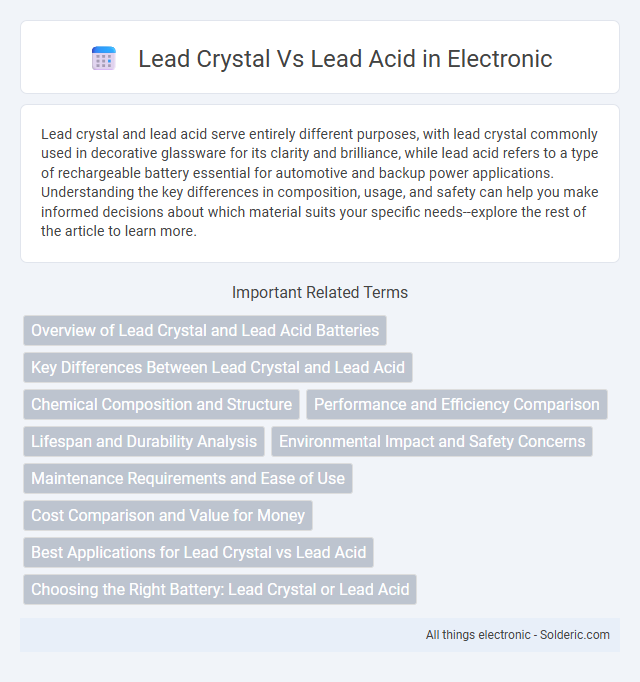Lead crystal and lead acid serve entirely different purposes, with lead crystal commonly used in decorative glassware for its clarity and brilliance, while lead acid refers to a type of rechargeable battery essential for automotive and backup power applications. Understanding the key differences in composition, usage, and safety can help you make informed decisions about which material suits your specific needs--explore the rest of the article to learn more.
Comparison Table
| Feature | Lead Crystal | Lead Acid |
|---|---|---|
| Composition | Glass with lead oxide | Lead plates and sulfuric acid electrolyte |
| Usage | Decorative glassware, chandeliers, awards | Automotive batteries, backup power, industrial use |
| Durability | Fragile, prone to breakage | Robust, long-lasting under proper maintenance |
| Weight | Heavier due to lead content in glass | Heavy due to lead plates and acid |
| Toxicity | Contains lead oxide, hazardous if broken | Contains lead and acid, hazardous if leaked |
| Recyclability | Recyclable but specialized process | Widely recyclable in battery recycling programs |
| Cost | Higher cost due to craftsmanship | Lower cost, mass-produced energy storage |
Overview of Lead Crystal and Lead Acid Batteries
Lead crystal batteries utilize a silica-based electrolyte that enhances charge acceptance and cycle life compared to traditional lead acid batteries, which rely on a sulfuric acid electrolyte. Lead acid batteries are widely used for automotive and backup power applications due to their low cost and high surge current capabilities, whereas lead crystal batteries offer improved deep discharge performance and reduced maintenance. Both types feature lead plates but differ significantly in electrolyte composition, resulting in variations in efficiency, lifespan, and environmental impact.
Key Differences Between Lead Crystal and Lead Acid
Lead crystal is a type of glass containing lead oxide, known for its clarity, brilliance, and use in decorative items, while lead acid refers to a type of rechargeable battery commonly used in automotive and industrial applications. The key differences lie in their composition and purpose: lead crystal is primarily silica-based with lead oxide for optical properties, whereas lead acid batteries contain lead plates and sulfuric acid electrolyte for energy storage. Durability and function vary significantly, with lead crystal prized for aesthetics and lead acid valued for electrical performance.
Chemical Composition and Structure
Lead crystal is composed primarily of silica (SiO2) combined with lead oxide (PbO), which enhances its weight, refractive index, and clarity, resulting in a dense, glass-like structure with a high degree of transparency and brilliance. Lead acid batteries contain lead dioxide (PbO2) at the positive plate and sponge lead (Pb) at the negative plate, immersed in sulfuric acid (H2SO4) electrolyte, where electrochemical reactions facilitate energy storage and release. Understanding these chemical compositions helps you distinguish the glassy, ornamental nature of lead crystal from the electrochemical functionality of lead acid batteries.
Performance and Efficiency Comparison
Lead crystal batteries typically offer higher energy density and superior charge retention compared to lead acid batteries, resulting in improved overall performance. Lead acid batteries generally have faster discharge rates but lower efficiency and shorter cycle life, making them less suitable for deep cycle applications. The enhanced electrolyte stability in lead crystal batteries reduces sulfation, increasing efficiency and longevity in demanding environments.
Lifespan and Durability Analysis
Lead crystal batteries typically offer a longer lifespan and enhanced durability compared to traditional lead acid batteries, often lasting up to 2-3 times longer under similar conditions. Their advanced construction reduces sulfation and corrosion, which are common causes of failure in lead acid batteries, resulting in improved cycle life and reliability. To maximize your energy storage investment, choosing lead crystal batteries can provide superior longevity and consistent performance in demanding applications.
Environmental Impact and Safety Concerns
Lead crystal contains lead oxide that poses risks of lead leaching and toxic exposure during manufacturing and disposal, raising significant environmental and health concerns. Lead acid batteries, while highly recyclable, can cause soil and water contamination if damaged or improperly disposed of due to sulfuric acid and lead content. Strict regulations govern both materials to minimize environmental impact and ensure safe handling to protect human health and ecosystems.
Maintenance Requirements and Ease of Use
Lead crystal batteries require minimal maintenance due to their sealed design, preventing water loss and reducing the need for regular inspections. Lead acid batteries demand more frequent upkeep, including checking electrolyte levels and topping off with distilled water to avoid damage. Your choice between these types will influence how much time and effort you dedicate to battery care and usability.
Cost Comparison and Value for Money
Lead acid batteries generally cost less upfront compared to lead crystal batteries, making them a popular choice for budget-conscious buyers. Lead crystal batteries offer longer lifespans, better deep discharge recovery, and reduced maintenance, providing superior value for money over time despite a higher initial investment. Your decision should consider both immediate cost and total cost of ownership to maximize efficiency and savings.
Best Applications for Lead Crystal vs Lead Acid
Lead crystal batteries excel in applications demanding high energy density and longer cycle life, such as electric vehicles and renewable energy storage systems. Lead acid batteries remain ideal for automotive starters, uninterruptible power supplies (UPS), and backup power due to their cost-effectiveness and reliable high current output. Choosing the right battery depends on your specific power requirements and operational environment.
Choosing the Right Battery: Lead Crystal or Lead Acid
Choosing the right battery between lead crystal and lead acid depends on application requirements, longevity, and maintenance needs. Lead crystal batteries offer superior cycle life, faster charging, and maintenance-free operation compared to traditional lead acid batteries, which are more affordable but require regular upkeep. For renewable energy systems and deep cycle applications, lead crystal batteries provide enhanced durability and efficiency, making them a preferred choice despite a higher initial cost.
Lead crystal vs Lead acid Infographic

 solderic.com
solderic.com